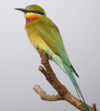
Real Birder
 |
Real Birder |
||||
| |
Menorca Oct 6th-Oct 20th 2000 |
| If I was asked to recommend a birding holiday in the Balearics for anybody who has more than a passing interest in birding, I would have to say Mallorca. Even with all its faults the diversity of habitats on Mallorca make it far superior to all the other islands. However we did visit Menorca on the 6th - 20th October 2000, although we did escape back to Mallorca during the second week of the trip for 4 days. As Menorca has been a popular holiday destination for many years I don’t intend to go into tourist information, suffice to say that you can easily get what ever you need for a successful birding holiday. Flights, Accommodation, Car Hire, etc, etc. We opted for a self-catering holiday and hired a villa at Son Bou overlooking the extensive marsh. This was our first disappointment. The marsh is covered with reeds with very little open water, making scopeing opportunities from our terrace extremely limited with only the odd Marsh Harrier, Heron, Duck and Cattle Egrets seen. Another cautionary note, and one that you don’t seen in the holiday brochures - Son Bou has a popular nudist beach and the marsh is a haunt for homosexual activities. We are not homophobic but it can come as a shock if, as we did, you start exploring the marsh with bins & scope, totally oblivious of such activities. Menorca is limited in the amount of good birding sites it has to offer. The main sites and the ones we found most productive are listed below:- Es Grau A vast body of water created to provide drinking water for the island. This is probably the premier birding site on the island as the trip report will testify. The reed-fringed bays can be productive for passage waders. A large development and golf course with the lovely name of “Shangri La” adjoins the site giving vehicular access to some high vantage points affording good views of the lake, although because of its size and shape, the whole of the lake can’t be scanned from any one vantage point. Tirant A series of pools and wetland, which are inland and can produce many of the birds & waders seen on the island. Most productive during the winter when the area is full of water and used by wintering ducks. In late spring & summer the area dries out. Salinas de Montgofre A favourite of ours, these old saltpans are on a private estate and permission should be sort prior to entry. I must be honest here and say, using the old train-spotting parlance, we bunked them as they seemed deserted. I have always found saltpans to be especially productive, due mainly to their suitability for wading birds. In the main they tend to be shallow allowing the water temperature to rise quickly in the spring allowing the rapid growth of algae and Brine Shrimp both are a valuable resource for hungry passage waders. Algendar Gorge This site is worth a visit if only because it’s the most spectacular birding site on the island. The gorge consists of lush vegetation on the valley bottom with a small stream giving way to very imposing limestone cliffs. Warblers can be found at the valley bottom with the cliffs home to breeding Egyptian Vultures, Booted Eagles, Peregrines and Rock Thrushes. On our visits the gorge held spectacular numbers of various butterflies.
Kingfishers appeared to have taken up residence on every body of water, including every stream that held even the smallest amount of water. Cattle Egret numbers also increased in the Son Bou area over the period, from 11 to 19 individuals, these birds roosted in the trees at the east of Son Bou Marsh. Late notable summer visitors were, 1 female Woodchat shrike, 12> Alpine Swifts, 1 female Pied Flycatcher, and a smattering of common Redstarts. House, Sand, & Crag Martins were all seen, with the two former going through during the period in pulses, although few Sand Martins were seen during the second week. Swallow passage was in full swing, with huge numbers seen most days, and many thousands roosted at Son Bou marsh. Any birders who visit Menorca or Mallorca and see Dartford Warbler should inform the (Grup Balear d’Ornitologia I Defensa de la Naturalesa) Tel 971 89 22 50. Email salbufera@oninet.es/general@dgmambie.caib.es
Pat and Judy Hayes |
| ©2012 Real Birder | Home • Photos • Trip Reports• Links • Contact Us |